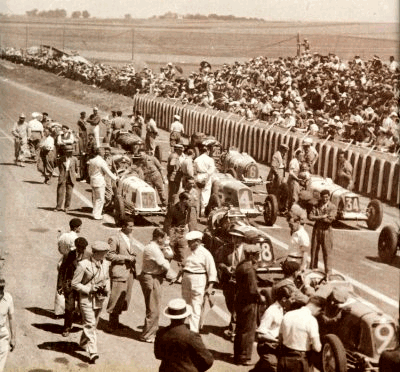 A grid full of Alfa Romeos, Bugattis, Maseratis lining up for the 1932 Grand Prix de la Marne at Reims.
A grid full of Alfa Romeos, Bugattis, Maseratis lining up for the 1932 Grand Prix de la Marne at Reims.
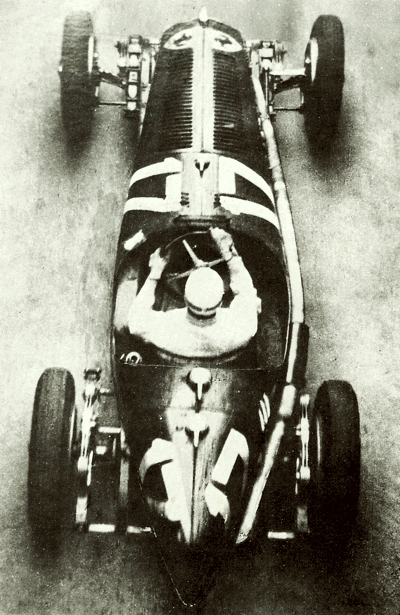 Achille Varzi's Alfa Romeo at the 1934 German GP at the Nurburgring. In Nuvolari's short absense from the team, he won seven races with this car.
Achille Varzi's Alfa Romeo at the 1934 German GP at the Nurburgring. In Nuvolari's short absense from the team, he won seven races with this car.
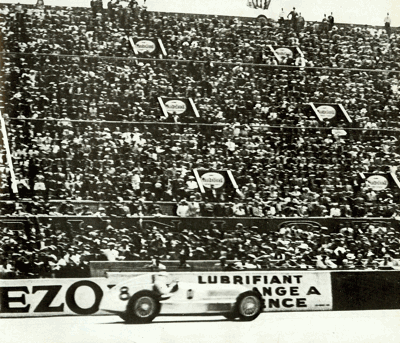
Rudi Caracciola screams past the Monthlery stand in Mercedes-Benz's first offering for the 750kg Formula for 1934. The Nazi sponsored W25, with its swing axles and unlimited budget, did not do all that well in France, with the Scuderia Ferrari Alfas storming home to a 1-2-3 victory.
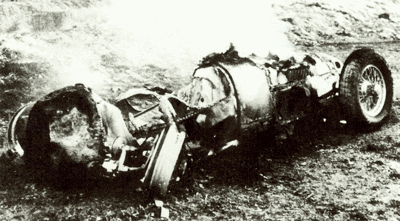
The Auto-Unions were great cars, but they were very difficult to control. One of the best at the art was Bernd Rosemeyer, who started his career in the Auto-Unions and became very adept with their handling issues. But even he came to grief at the 1936 Tunis GP, his C-Type catching fire after crashing out.
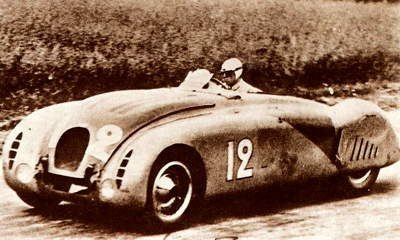
Jean-Pierre Winmille in his 3.3 liter Bugatti wins the 1936 French GP at Montlhery.
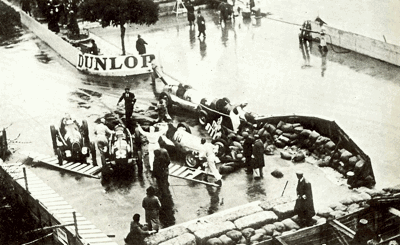
The 1936 Monaco GP is thrown into confusion after Tadini's Alfa Romeo dropped its oil at the chicane.
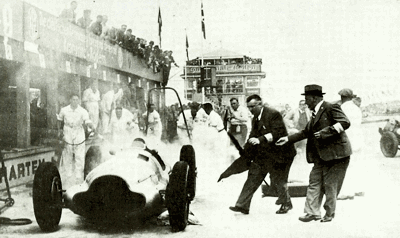 A rare problem for the crack Mercedes-Benz team. Pictured is Manfred von Brauchitsch, the "Pechvogel" (unlucky bird) in 1938 - after coming into the pits for a routine refuelling stop his car caught fire. To the right of the picture is Alfred Neubauer, team manager, who directed the fire fighting effort. The flames doused, von Brauchitsch re-joined the race but needed to push it to the limit, and eventually he ran off the road.
A rare problem for the crack Mercedes-Benz team. Pictured is Manfred von Brauchitsch, the "Pechvogel" (unlucky bird) in 1938 - after coming into the pits for a routine refuelling stop his car caught fire. To the right of the picture is Alfred Neubauer, team manager, who directed the fire fighting effort. The flames doused, von Brauchitsch re-joined the race but needed to push it to the limit, and eventually he ran off the road.
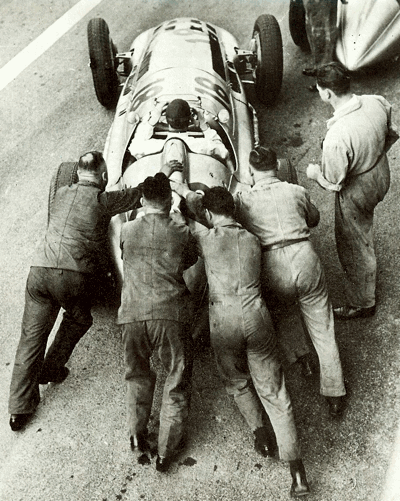 Four mechanics struggle to push start the 1939 W163 Mercedes-Benz of von Braughitsch at the French Grand Prix at Reims.
Four mechanics struggle to push start the 1939 W163 Mercedes-Benz of von Braughitsch at the French Grand Prix at Reims. |
By 1930 the new Maserati cars were in the ascendant. Alfa Romeo's only important wins were at Alessandria, where Varzi dominated the field, winning the Bordino Prize race at 67.7 mph after he had lapped at the record speed of 70.7 mph and in the
Targa Florio, which he won at 48.48 mph, again making a record lap speed of 49.1 mph. Once more, this was a staggering demonstration of the endurance of the old P2 Alfa Romeo, even though they had been modified for 1930 conditions and challenges. The
Type 35 2.3-liter Bugattis were in the next two places.
Rene Dreyfus
A private owner, Rene Dreyfus, had scored in the 1930 Monaco Grand Prix in his Bugatti, a Type 35C, at 64.63 mph, which was a brilliant speed for the winding course. The new straight-eight 2.5-liter Maserati had quickly come into its own, taking Arcangeli to victory at Rome, when Chiron's Bugatti failed right at the end, and Maserati cars gave wins to Fagioli in the Coppa Ciano and to Varzi at San Sebastian.
Not only that; at Monza, Varzi drove a magnificent race to win the Monza GP in a 2.5-liter car of the then new make, having passed both Arcangeli, who was leading in a Maserati of the same type, and Maserati's own V16-engined model. Etancelin took the French GP for Bugatti, at Pau, with Birkin behind him in a stripped blower 4.5 Bentley sports-car. Clearly, Alfa Romeo needed the new Monza and monoposto cars, for the aged P2 chassis could no longer stand up to the tuned engines which were used in them.
The 10 Hour Grand Prix
All thoughts of a Formula to control design had gone overboard by 1931, but it was stipulated that Grand Prix races should last for ten hours. This meant that two drivers would usually be nominated for each car and gave rise not only to an increased necessity for pit-work but to a new headache for team managers in deciding whether or not to take a top-ranking driver out of a disabled car and allow him to take the place, in one of their fitter vehicles, of a slower driver.
It was an interesting but perhaps a boring period of racing; one of the highlights was the intensifying of the Bugatti-Alfa Romeo duel. The 1931 season opened with the
Targa Florio race, over a new and longer circuit adopted because a land slide had obliterated much of the former course. Chiron had already won the Monaco Grand Prix for Bugatti, who now had his new twin-cam, 160 bhp engine in the excellent and beautiful Type 35 cars. This updated version was designated the Type 51.
Alfa Romeo replied with the Monza model and in the Targa Florio, over the Long Madonie course, Nuvolari, driving one of these new cars from Milan, gradually wore down the lead established by Varzi's faster Bugatti, to win at 40.3 mph. The low average speed was indicative of the road and weather conditions. Front mudguards were used on Nuvolari's Monza to keep streams of rain water out of the cockpit. Varzi had some consolation in setting fastest lap at a mere 43.8 mph.
The 1931 Italian Grand Prix
The first really big race of the season was the Italian Grand Prix at Monza where strong works teams from Alfa Romeo and Bugatti clashed in full force. Apart from the Monzas, Alfa Romeo had a remarkable new twin-six-cylinder monoposto, of 3.5-liters, and developing some 200 bhp. This was entrusted to Tazio Nuvolari. It was not as successful as had been hoped; Nuvolari only managed to reach third position, after three out of the ten hours' racing. He then retired but in the later stages of the race he aided the veteran Campari in bringing his Monza home first, at 96.17 mph.
Varzi's Type 51 Bugatti had dropped out, while leading, with back axle failure, only four hours into the race. Alfa Romeo also set a new lap record at 105 mph, although this was actually only a very small improvement over the old, 1924, record for the full Monza Autodrome course. A sports Mercedes-Benz was able to take victory at
Nurburgring, with
Rudolf Caracciola winning at 67.67 mph and then the French Grand Prix, held at the Montlhery road circuit, saw a resumption of the French/Italian inter-marque rivalry.
This time Bugatti were the victors, Chiron and Varzi, usually great rivals, united for once and won, at an average speed of 78.21 mph. It had been a good race for the newcomers, Maserati & Luigi Fagioli, driving one of the 2.5-liter straight-eight racers that had shown up well in 1930, established the fastest lap, at 85.6 mph, which was a record for this much-used circuit. Fagioli had been well placed for four of the ten hours over which this historic title was defended, but he then dropped back with brake maladies.
Bugatti Domination
Despite the Maserati's promise, the battle in this race was still very much between the Alfa Romeo and Bugatti cars and a Monza Alfa driven by Campari and Borzacchini finished in second place. Their Monza ran 27 fewer miles in the ten hours of the race than did the winning Bugatti, but then the victorious French car had lost only 10
½ minutes at its depot, during just five stops, while the Alfa Romeo spent 24 minutes refuelling and being generally resuscitated.
The Coppa Acerbo
After this, Bugatti more or less dominated the 1931 season, with victories at Reims, Spa and in Czechoslovakia, the winning drivers being, respectively, Lehoux, Williams, with Count Conelli, and Chiron. At the
Nurburgring for the German Grand Prix of 1931, Caracciola in a big, even when stripped, 7-liter Mercedes-Benz sports-car triumphed over all the smaller racing cars, averaging 67.4 mph. Campari's Alfa Romeo won the Coppa Acerbo at 81.68 mph, the lap-record going to Nuvolari, also driving for Alfa Romeo, at 83·4mph.
The driver and manufacturer rivalry returned with a vengeance at Monza for the non-Formula Italian Grand Prix. Run over a shortened 4.3-mile, course, the 14-lap event was a walk-over for the Maseratis which had been enlarged to 3.8-liters for the occasion and finished with Fagioli first and Dreyfus second. The unlimited-capacity contest saw such great cars as the twin-eight, sixteen-cylinder Maserati and the 4.9-liter Type 54 Bugatti locked in combat. The big, 152 mph, Maserati was totally unsuitable for this kind of race and it was Varzi who won bravely with a 4.9-liter Bugatti, at 98.5 mph.
Nuvolari set a short-course lap-record of 101 mph in a twelve-cylinder Alfa Romeo. From within a field of some of these road-racing giants, the final showed up the superiority of the smaller 2.8-liter Maserati and Fagioli took the honours with victory at 96.6 mph, including the time for a pit-stop to change tyres. Borzacchini was second in a Monza Alfa Romeo, while Nuvolari had to be content with third place in the twelve-cylinder Alfa Romeo. Achille Varzi gave of his best in the dangerous Type 54 Bugatti but was hampered by bursting tyres.
Robert Senechal
At the French GP Robert Senechal drove a 1.5-liter, eight-cylinder Delage to fifth place after driving the entire ten hour duration himself. He is remembered as the enthusiast who, when the Delage team was in dire trouble with their cars virtually cooking the drivers in 1926, leapt onto the track to take over, wearing a normal gentlemans suit and presumably with no experience of Delage's heating problems.
Fortunes changed in 1932 and Bugatti was out of the running, except for the Czechoslovakian GP which Chiron won at 67.67 mph. Otherwise, it was the season of the P3 monoposto Alfa Romeo ably supported by the older model. Honours were divided between Nuvolari and Caracciola, a new addition to the Alfa ranks. Nuvolari won at Monaco at 55.81 mph in the Targa Florio at 49.27 mph, at Monza (for the Italian GP) at 104.13 mph and in the French GP at Reims at 92.26 mph. He also won the Coppa Ciano and Coppa Acerbo races. Caracciola soon settled down in the team and the German driver scored at the Eifel races at the
Nurburgring, at 70.2 mph, in the German GP over the same demanding circuit at 74.13 mph, and again in the Monza Grand Prix, averaging 110.8 mph. Nuvolari set fastest lap in the latter race at 113.7mph, which was another record for the Monza course.
The following year, 1933, was one of economic recession, with the German Grand Prix cancelled as a result and Maserati and Bugatti once again racing their Type 51 and 2.9-Iitre cars, respectively. Moreover, Alfa Romeo retired from racing and their former successes were only slowly retrieved by the Scuderia Ferrari, which, at first, entered modified Monza cars. The race distance demanded by the regulations was reduced to 500 kilometres and the major races of 1933 were the Monaco, French, Belgium, Italian, and the revived Spanish Grands Prix. Monaco displayed the full drama of the times, with the antagonists, Nuvolari and Varzi engaging in a ferocious battle round and round the town, until Nuvolari's Monza broke a vital oil-pipe and caught fire on the final rush down to the finish. Nuvolari jumped out of the cockpit and sought to push his flaming car over the line but it was Varzi's Type 51 Bugatti that received the victor's laurels, his winning speed being 57.04 mph. Umberto Borzacchini brought a Monza Alfa into second place.
Charles Faroux's Qualifying Idea
It is interesting that, at the insistance of Charles Faroux, the then well known French motoring journalist, the start at Monaco had been based on a grid assembled on practice times, predating the modern system by many years. It was felt that on this narrow and tortuous circuit it would be unfair to draw the positions out of a hat, as was the usual method. The system made Varzi's victory entirely convincing, but did not come into general use in Europe until 1935. Bugatti did not manage a win in the French Grand Prix, because his new 3.8-liter racers were not ready. Instead, a host of privately-entered cars of this famous make ran, but they were no match for Campari's 2.9-liter Maserati, which commanded the race and won at 81.52 mph and also set a new lap record for the Montlhery road-cum-track circuit of 86.6 mph.
Out of a dozen Monza Alfa Romeos that started, those of Philippe Etancelin and George Eyston took second and third places, while Nuvolari was so upset over the preparation of his Ferrari-sponsored car that he afterwards changed his alligiance to Maserati. This paid off for the little maestro, because he won the Belgian Grand Prix at the fine Spa road circuit, at 89.23 mph, after breaking the lap record, at 92.33mph. Varzi was some three minutes behind Nuvolari, in a Bugatti, a close finish for those days, with another Bugatti, handled by Dreyfus third. So the bitter battle between Nuvolari and Varzi continued unabated.
Alfa Romeo managed to win the
Targa Florio (Brivio, at 47.56 mph), but at the Coppa Ciano race Maserati was again in the ascendant over the aged Monzas. The same thing might well have happened in the Coppa Acerbo race had not the Scuderia Ferrari been permitted by the Alfa Romeo company to have the use of the new P3 single-seaters. Even so, Nvuolari proved able to out-race them in the Maserati, but he was obliged to come into the pits. Then Campari's P3 Alfa, which had been tailing Nuvolari, retired, so that by virtue of a non-stop run, Fagioli, in his Alfa, was the first past the finish, at an average speed of 88.03 mph, although Nuvolari had broken the old lap record, at oo.a mph. , This was all a good augury for the remaining important Grand Prix contests.
At the Italian event, run over a full fifty laps of the complete Monza Park circuit, Nuvolari's 2.9-liter Maserati met formidable foes, in Louis Chiron and the wily Luigi Fagioli, both driving P3 Alfas. Nuvolari put up his expected terrific performance, but a burst tire slowed him down and allowed Fagioli to win, at 108.58 mph. Towards the end, Fagioli lapped at the record pace of 115.82 mph, but Nuvolari the master still finished second, only 0.63 mph slower. In the afternoon of the same day, the Monza Grand Prix was run, using the short Monza circuit. It was a tragic race, in which oil on a corner cost the lives of Count Czaykowski (Type 54 Bugatti), Guiseppe Campari (Alfa Romeo P3) and Umberto Borzacchini (Maserati 8C). The winner proved to be Lehoux's Bugatti, at 108.99 mph, with a posthumous lap-record, to the credit of the Count at no less than 116.81 mph.
Still to come in 1933 was the Spanish Grand Prix and in this race Ettore Bugatti campaigned his new 2.8-liter cars. The design for these cars led directly to that for the next season's fine 3.3-liter models, but on this initial occasion there was no way that they could equal the performance of the P3 Alfa Romeos, one of which, Chiron's, won at 83.32 mph. However this victory was possible only after Nuvolari, comfortably in the lead for Maserati, had gone off the road into a tree. During the last two seasons, it had become evident that political factors were creeping into motor racing, which initially had been a contest between nations (the Gordon Bennett races) and later, with quite lucrative money to be earned by the top drivers, had become a means of gaining publicity and improving design for the automobile manufacturers (the French Grands Prix etc).
Mussolini's 'Win for Italy' Edict
Mussolini was apt to send the Alfa Romeo drivers - and those of other Italian-made motor cars - telegrams before a race, saying in effect, 'Win for Italy'. He had also been known to try to smooth out the rough passage between Nuvolari and Varzi, in the hope of securing further Italian-based successes. Now, with Herr Hitler planning to annex the non-German con- stituents of Europe, racing took an even more obviously political turn: henceforth Mercedes-Benz and Auto Union were expected to dominate all the major motor races for the prestige of the Nazi regime and Hitler somehow saw to it that enough finance "was made available to each of these racing teams for them to conquer all before them (or, more correctly, alongside them).
This they eventually did, with fabulous cars, the like of which, in speed, sight, sound and smell, no-one outside German had previously seen, as they stormed the bastions of European motor-racing circles. It took time, of course. The first of the new 3.3-liter, independently sprung Mercedes-Benz racing cars and the highly unconventional Auto Union rear-engined projectiles arrived on the scene in 1934, but for the 1934 Monaco race they were not ready. It was pipe-smoking Count Trossi who lapped at record speed for Alfa Romeo, at 59.7mph, and Guy Moll who won for the same Italian racing stable, in the P3, now of 2.0-Iitres capacity, averaging 55.86 mph.
The much-feared German onslaught commenced with the Avus race on the fast course near Berlin in May 1934, but after lapping in training at 143 mph Mercedes-Benz decided that their cars were unready and required more work to be done on them. The Auto Unions remained to fight and although two of them retired, leaving Moll to win for Alfa Romeo in a special Scuderia Ferrari car, with faired body and 3.2-liter engine, at an average of 127.56 mph, the inexperienced Momberger came in third for Germany, behind Varzi's Alfa Romeo.
Manfred von Brauchitsch
Auto Union had lapped fastest, at 140.33 mph. At the
Nurburgring, the writing on the wall received its signature, as in the Eifel races Manfred von Brauchitsch, in one of the then new Mercedes-Benz cars, led throughout, followed by Italian Fagioli in another of the German cars. Fagioli had the edge on Brauchitsch and wanted to lead but he was signalled to let the German driver stay in front. Not liking Nazi orders he stopped, got out of the Mercedes-Benz, and walked away. This let the Auto Union of Hans Stuck, the hill-climb ace, into second place, and the best Chiron could manage for Alfa Romeo was third place, even though the two German cars had needed to stop for fuel and the Alfa Romeos had run non-stop.
Following a walkover for Alfa Romeo in the Penya Rhin GP, the German cars returned to challenge them at Montlhery for the French Grand Prix in July. However, both Mercedes-Benz and Auto Union ran into countless troubles and left the race to the Italian cars, Chiron, Varzi and Moll carrying out a 1-2-3 drubbing with their Alfas and the new 3.3 Bugattis being completely out-classed.
Louis Chiron
Louis Chiron was the hero of France, having trounced the terrible German opposition, winning at 85.5 mph. Alfa Romeo then pulled off the Marne GP at Reims at 90.71 mph, Chiron winning and Varzi setting best lap, at 97.65 mph. The great run of success for the P3 Alfa Romeo drivers was on the wane, however. From now on, apart from isolated Bugatti joy at Spa, where Dreyfus won at nearly 87 mph and Brivio, likewise Bugatti-mounted, put the circuit lap record to 96.38 mph, it was German domination all the way.
Hans Stuck
The Bugatti victory was carried out without opposition from either of the German teams after Chrion had over-turned his Alfa Romeo and Varzi had broken a piston trying to prove that not only Nuvolari could take lap records. After that, there were only the Bugattis left in the hunt. Apart from this, the rest of the season made dull reading for any but the German Nazi Party, with Hans Stuck taking the Auto Union first past the flag at the
Nurburgring to win the German Grand Prix at 75.14 mph.
He set the best lap at a record 79.29 mph in the process. Fagioli made up for his show of nationalistic temperament at Spa, by winning for Mercedes-Benz at Pescara (80.26 mph average) after Moll's Alfa Romeo had increased the lap record to 90.5 mph and then crashed with fatal results. In this race Nuvolari was second in a Maserati and Brivio's Bugatti managed to finish third. Stuck won the Swiss Grand Prix at 87.21 mph for Auto Union, Momberger also showing form by putting the lap record for the course up to 94.42 mph, Brivio's Bugatti was again well up until it needed water.
The Italian Grand Prix over the short Monza course was a victory for the Mercedes-Benz of Caracciola and Fagioli at 65.37 mph, with Stuck, troubled by brake weakness, second and an Alfa Romeo third. The German domination was not yet complete, however, for in the Spanish Grand Prix it was Mercedes-Benz drivers Fagioli and Caracciola first and second, but Nuvolari was third for Ettore Bugatti.
In the Czech Grand Prix, the final race of this astonishing 1934 season, while Stuck's Auto Union trounced Fagioli's Mercedes-Benz, the resolute Tazio Nuvolari, now driving a Maserati, again came home in third position. The winning averages for these two races were 97.13 and 79.21 mph, respectively. Clearly, motor racing was becoming faster and far more exacting and although Germany intended to win, Hitler showed plenty of cunning by ensuring that she had two rival teams in the field.
The remainder of the 1934-36 period was one of German domination had now been achieved. In 1936 Auto Union played while Mercedes-Benz mainly fiddled with mechanical troubles, but 1935 had been a Mercedes-Benz year. They won at Monaco (Fagioli), the Eifel (Caracciola), Penya Rhin (Fagioli), Montlhery for the French GP (Caracciola), at Spa (Caracciola), at Berne for the Swiss GP (Caracciola), and at San Sebastian for the Spanish GP (Caracciola), leaving only the Tunis GP (Varzi), the Coppa Acerbo (Varzi), the Italian GP at Monza (Stuck) and the Czech GP at Brno (Rosemeyer) to Auto Union.
The German GP
Yet in the German Grand Prix, played on their home ground at the Niirburgring, it was the talented Nuvolari who vanquished the. entire might of Germany, before all those German spectators, driving an aged P3 Alfa Romeo. He achieved this great victory after an infuriating fuel stop when the refuelling pump broke down and cans has to be substituted, so that the P3 was stationary for over 2 minutes, compared to the Germans' pit-stop of well under one minute! Nuvolari was also the winner in the Coppa Ciano for Alfa Romeo, and he made fastest lap in the Italian GP in one of these cars.
Otherwise, apart from a win for Dreyfus' Alfa Romeo at the Marne GP, it was Germany all the way. As has been said, Auto Union were in the ascendant in 1936. With the formerly important Belgian, Marne and French Grands Prix relegated to sports car status and the Czech and Spanish Grands Prix abandoned, it was victory after victory for the odd rear-engined cars. Mercedes-Benz pulled off a solitary win at the Tunis GP at Carthage (Caracciola), and at Monaco (Caracciola) and there was lingering Alfa Romeo success when Nuvolari took the Penya Rhin, Hungarian, Milan and Coppa Ciano races for Italy.
Otherwise 1936 was Auto Union's year, with victories over Mercedes at Tripoli with Varzi first and Stuck second, the Eifelrennen (Rosemeyer), in the German GP (Rosemeyer first, Stuck second), the Coppa Acerbo (in the order of Rosemeyer, von Delius, Varzi), in the Swiss GP (Rosemeyer beating Varzi and Stuck), and in the Italian GP, which Rosemeyer won from Nuvolari's Alfa Romeo with von Delius third.
Auto Union were very fortunate to have secured the services of the young Bernd Rosemeyer, a former motor cycle racer, and it was an enormous loss to them when he was later killed attempting to break high-speed records for them when a savage cross wind upset his car. In the Eifel Grand Prix of 1936 he had to drive in heavy rain which turned to mist, but he won all the same, at an average speed of 72.71 mph as well as lapping faster than the old-timers of greater experience, at a speed of 74-46 mph.
It is noticeable that although Germany would have preferred to have used entirely German drivers for their two winning teams, so fast and difficult to handle were these cars, particularly the over-steering Auto Unions, that French and Italian drivers had to be called in, and Nuvolari, and Dick Seaman from Britain were to follow.
Under political influence, racing had become more exciting in respect of speed and spectacle, and more intense as the well organised and capably engineered German teams came to show the rest of the world their superiority. In 1937, the FIA in Paris had intended to curb speeds by introducing a maximum weight limit of 750 kg, but the advances in metallurgy, readily available to the government-financed Mercedes-Benz and Auto Union teams, opened the door to enormous power from ultra-lightweight motor-cars. But the new use of softer and increased-travel suspension systems was not yet fully understood, so that the high speed and very quick acceleration of the new racing cars put a great strain on their drivers as well as making Grand Prix contests a fine sport to watch. The Titans were in action!
The 1937 season opened in Rio de Janeiro, for Grand Prix racing "vas increasing in popularity and new countries sought Grand Prix status. Here the winding course allowed Carlo Pintacuda to bring the 400 bhp, all-indepen- dently-sprung, 4-liter, V 12 Alfa Romeo in first, at 51.5 mph, ahead of Stuck's Auto Union, four seconds in arrears. Also, in the Milan Grand Prix Nuvolari got his Alfa Romeo in front of Has se's Auto Union, winning at 64.4mph and setting the lap record to 67.8 mph. But Formula racing as such did not start until the Eifel races in June and now superior German speed and preparation prevailed, Rosemeyer winning for Auto Union at 82.56 mph from the Mercedes-Benz of Caracciola and von Brauchitsch, these latter cars having been troubled by fuel-feed problems. Nuvolari could only manage fifth.
Playing far away from home, the German and Italian teams then went to the Roosevelt Speedway in New York State for the Vanderbilt Trophy and found rather unexpected conditions. Even so the American cars could do no better than seventh, although Rex Mays, driving a 3.8-liter Alfa Romeo with a centrifugal blower, was a threat to the German cars. As it was, Rosemeyer sailed away into an easy lead to win for Auto Union at 82.95 mph, with Seaman second in a Mercedes-Benz. Back in 1937 it was not possible to get the teams back over the Atlantic soon enough to compete in the Belgian Grand Prix at Spa, but Mercedes-Benz and Auto Union had cars and drivers in reserve.
Their might was evident when Lang's Mercedes was timed over the flying-kilometre at 193 mph and the old lap record was pulverised again and again. But in the race these very quick Mercedes cars ran into various troubles, leaving Hasse's Auto Union to win at the very high pace of 104.87 mph, after Caracciola had left the Spa lap record at I08.8mph. From then on it was Mercedes dominance all the way, with victories at Niirburgring in the German Grand Prix (Carracciola, 82.77 mph), at Monaco (von Brauchitsch, 63.25 mph) in the Swiss Grand Prix at Berne (Caracciola, 97.42 mph), in the Italian Grand Prix at Leghorn (Caracciola, 81.59mph), and at Brno (Caracciola, 85.97mph), with many new lap records en route. Behind these statistics lies some of the most exciting and worthy motor racing of all time.
The brilliant Rosemeyer brought Auto Union some consolation with wins at the Coppa Acerbo at 87.61 mph and a new lap record of 92mph, and in the Donington Grand Prix, at 82.86 mph, where he shared the lap record with Caracciola's Mercedes at an impressive 85.62mph. By 1938 the 3-liter Grand Prix cars were the vogue, with highly-supercharged, short-stroke engines, not much slower than the bigger cars that had preceded them, but not quite so dangerous to handle, for the new-style springing was now beginning to be understood by racing-car engineers. Alfa Romeo came up with their new Tipo 308 but were entirely outclassed, and Auto Union, who lost Bernd Rosemeyer at the beginning of the 1938 season, had hardly better luck, although Nuvolari managed to give them a win in the Donington Grand Prix. In this event many of the other ace-drivers had been eliminated because of oil dropped on the course.
The crowds were again of immense proportions for a race meeting in Great Britain and the roads leading to the Leicestershire circuit were jammed with traffic. With good reason, too, for the German teams with their supporting fleets of vehicles and armies of mechanics plus the legendary Herr Neubauer controlling the Mercedes-Benz racing, were worth going far to see. The occasion was all the more dramatic because of the threat of imminent war and Nuvolari won at 80.49 mph and made a fastest lap of 83.71 mph. During the year, Auto Union netted only one more win, at Monza, and all the other races were Mercedes-Benz victories. At Pau, however, Rene Dreyfus took first place for Delahaye, by a whole lap, as Mercedes grappled with heavy fuel consumption, calling for pit stops in under ninety miles, and gear-shift troubles. Nuvolari did not start, having suffered burns. when his Alfa Romeo caught fire in practice.
The remaining Auto Union victory at Monza was less spectacular because the race organisers had toned down the great pace of the 1938 racers by building chicanes on the course. Tazio Nuvolari drove the winning car at 96.7 mph but Lang had set fastest lap in his Mercedes-Benz at a record IOI.38mph. Otherwise, 1938 and the shortened 1939 3-liter seasons were full of Mer cedes successes. In 1938 Caracciola took the honours at the Coppa Acerbo at an average speed of 83.69mph but, surprisingly, Villoresi's Maserati did fastest lap, at 87.79 mph. He also won the Swiss Grand Prix at 89-44mph, while Manfred von Brauchitsch scored at the French Grand Prix at Reims averaging IOI.3 mph. Britain's hero, Richard Seaman, won a memorable German Grand Prix at the
Nurburgring at 80.75 mph, also setting fastest lap at 83.76mph (and being noticeably shy on the victor's rostrum of returning a full Nazi salute).
Very soon after, he was tragically killed at Spa, skidding into a tree in the wet and being dragged from his blazing Mercedes-Benz to die in hospital. Lang, a former racing mechanic, won the Coppa Ciano at 85.94 mph, sharing the record lap of 89.17 mph with his team-mate von Brauchitsch, and it was Lang who showed us a lap of 101.38mph at England's first Grand Prix road racing circuit, Donington Park. With the outbreak of war in September 1939, that season came to a premature close, but not before several races had been contested. Mercedes-Benz took all but the French Grand Prix and the Yugoslav Grand Prix; the latter event was actually held after war had broken out and marked an even greater spread of political international motor-racing.
This, the last European race for many years, was won by Nuvolari's Auto Union at 81.21 mph, after he and von-Brauchitsch (who was a nephew of the German Field Marshal), had roused Belgrade with a joint lap record of 83.9 mph. Otherwise, the season was dominated by the cars from Stuttgart. Caracciola was victorious in the German Grand Prix at the
Nurburgring. The classic circuit was built with previously unemployed labourers after World War 1. Caracciola averaged 75.12 mph, and lapped at 81.66 mph in the last pre-war race. Lang took the Swiss Grand Prix at Berne at 96.02 mph but team-leader Rudi Caracciola set a very fast new lap record, at 104.32mph.
The last pre-war French Grand Prix at Reims had been even quicker, and Lang lapped at a record 114.87 mph. Even so, Muller's Auto Union won at I05.25 mph, after a smoking Mercedes announced that Lang was in dire mechanical trouble. Lang was certainly in the ascendancy however, having won at Pau and in the Eifel races. Thus the 1939 season ended with German cars supreme.
